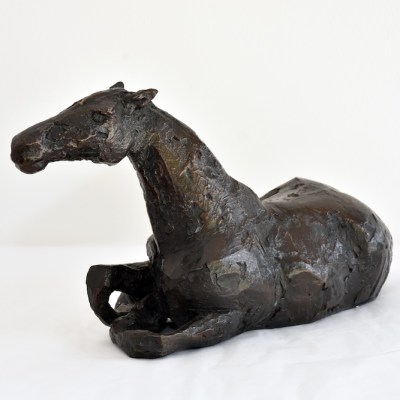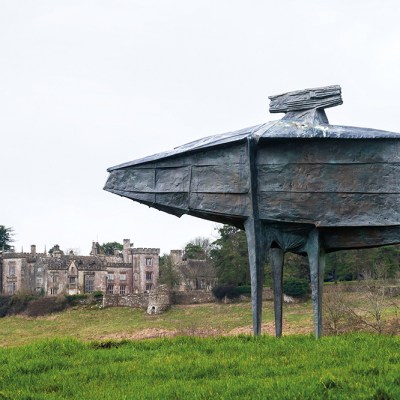From the May 2025 issue of Apollo. Preview and subscribe here.
Joni Mitchell must be smiling. As part of its $53-million expansion, opening on 7 May, Storm King Art Center in Mountainville, New York, has planted over not one but two parking lots and turned them into an outdoor art lover’s paradise. The overhaul has added nearly five acres of natural space for the installation of artworks and programming, around 650 trees and 20 types of local plants, as well as a more welcoming ‘outdoor lobby’ for visitors and a new conservation and fabrication building, for the care and creation of artists’ projects. Planning for the expansion, which started in 2017, involved thinking about more than building improvements and visitor amenities, says Nora Lawrence, the institution’s recently promoted executive director. ‘It’s about who we are and what we’re known for,’ says Lawrence, who led the capital project, the first in Storm King’s 65-year history, ‘and what we want to bring to the table.’
What Storm King is known for is a more than 100-work collection of monumental art displayed across a rolling two-square-kilometre landscape nestled amid the Hudson Highlands, which includes the nearby mountain from which it takes its name. First opened to the public in 1960 by the art patron Ralph E. Ogden and his son-in-law H. Peter Stern, the institution was originally meant to house paintings by the Hudson River School artists but soon pivoted to displaying work by modern sculptors such as Mark di Suvero, David Smith and Alexander Calder. It continues to present ambitious projects by contemporary artists – often giving them their first opportunity to create outdoor large-scale works. The opening of the expansion includes a number of new exhibitions and acquisitions.
View of The Arch (1975) by Alexander Calder, which stands next to Storm King’s new welcome pavilions. Photo: Jeffrey Jenkins; © 2025 Calder Foundation, New York/Artists Rights Society (ARS), New York
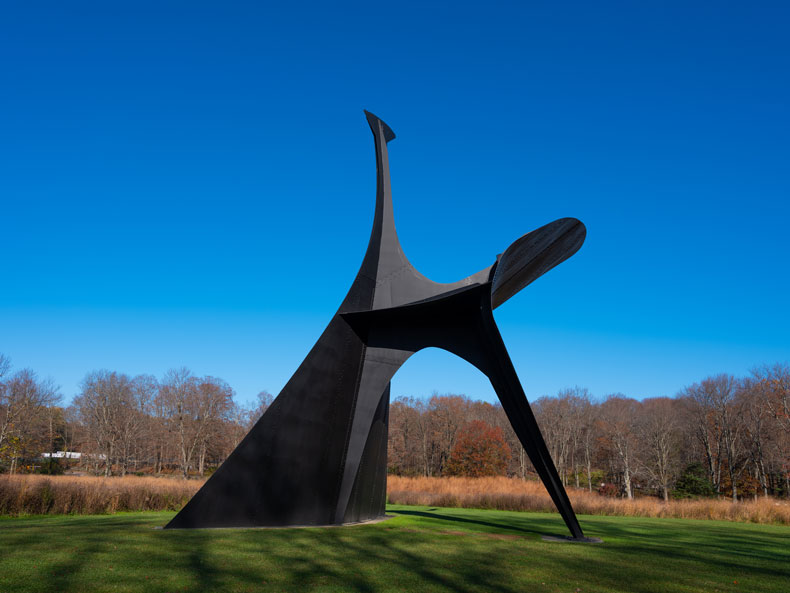
For example, in the newly reclaimed Tippet’s Field, which used to be the main parking lot, Kevin Beasley is presenting his largest project to date, PROSCENIUM | Rebirth / Growth: The Watch / Harvest / Dormancy: On Reflection (2025), a series of four triptychs composed of found fabrics and materials suspended in resin, each set of panels representing a season of the year and installed in the shape of a 30-metre-long theatre arch. Its placement is not just a chance to try out the new exhibition space. ‘It’s also going to be giving a lot of this field back to the public,’ Lawrence says. ‘We’re going to do performances here in collaboration with Kevin.’ Working with the artist on that programme underlined to Lawrence how central the location is to the site. ‘That’s why there was a parking lot there […] but also why it’s such a great new space for art.’
The transformation of an expanse of asphalt into a natural environment is part of the redesign by an international team, including New England landscape architects Reed Hilderbrand (who also replanted the eye-catching allée in the South Fields in 2019, replacing a line of dying maples with more resilient tupelo trees), Gustafson Porter + Bowman from London, Heneghan Peng architects from Dublin and WXY Architecture from New York. In Tippet’s Field, this meant infilling the once-flat lot so that it melds seamlessly into the surrounding hills and meadows, adding a gradiant of just over a metre as well as narrowing the roads and pedestrian walkways. The other smaller parking lot, now the new North Field, situated near an existing outdoor cafe and picnic tables, has had a more dramatic makeover, uncovering a once-buried stream and adding a picturesque footpath. While this new location is not yet being used to display art – though a newly acquired work by the artist Lee Ufan, Relatum – Horizontal and Vertical (2019), has been installed nearby – the potential is there. ‘It is going to be this beautiful natural space with lots of different native wildflowers and grasses,’ Lawrence says.
View of PROSCENIUM | Rebirth / Growth: The Watch / Harvest / Dormancy: On Reflection (2024–25) by Kevin Beasley. Photo: Jeffrey Jenkins; courtesy the artist/Casey Kaplan, New York/Regen Projects, Los Angeles; © Kevin Beasley

Such efforts to restore the landscape are part of Storm King’s history. When the property was first acquired by Ogden in 1959 from the estate of his friend, the lawyer Vermont Hatch, it had been severely altered due to construction of the adjacent New York State Thruway, which required the removal of one million square yards of gravel from the fields. The site was in a state of rapid decline, with virtually no topsoil left, so one of the first orders of business for Ogden and Stern was to heal the environment, which they did with the help of landscape architect William A. Rutherford, Sr. Over the next few decades, Storm King’s campus would be expanded with the addition of neighbouring properties and the scarred landscape would be intentionally ‘sculptured’, as Rutherford described it, to create appealing vistas and purpose-built platforms to display art.
The most noticeable change with this latest expansion is in how visitors will arrive at Storm King. A new parking area (sorry Joni) has been built closer to the top of the road leading to the museum campus, with a looping drive that allows buses and ride share cars to easily drop off groups and visitors arriving via public transport (both New Jersey Transit and New York’s Metro North Railroad have train stations nearby). This new centralised arrangement is meant to better accommodate the more than 150,000 visitors who come to Storm King annually – around double the number it received when planning for this expansion began in 2012 – which peaks in October with the autumn foliage, just before the site closes for the winter in November.
View of Personage of May (1956–57) by David Smith in the grounds of Storm King Art Center. Photo: Jerry L. Thompson; © 2025 The Estate of David Smith/Artists Rights Society (ARS), New York
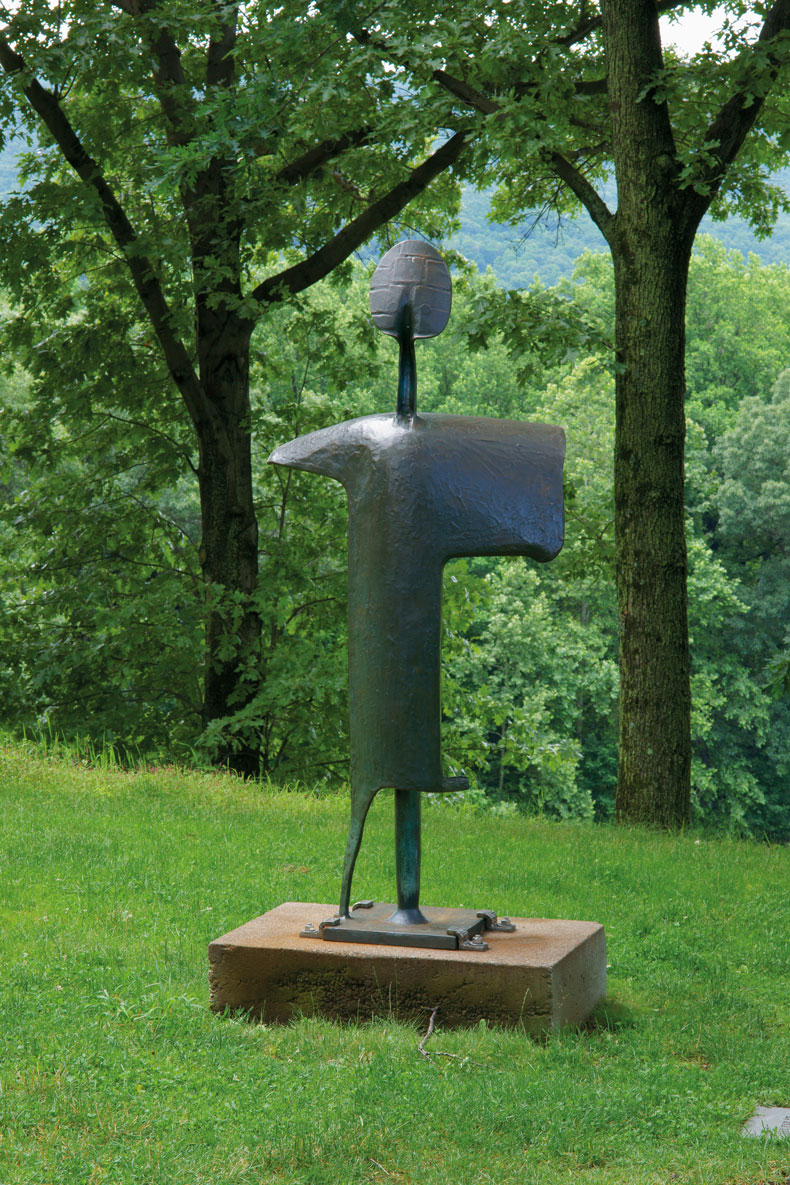
The ‘outdoor lobby’ is an open-air space centred around a historic house on the property, built in the 18th century and added to in the 19th, which has been updated with a new extension for ticket sales. Modern amenities include lockers, a first-aid station, nursing room and toilets in a purpose-built structure, parts of which are open to the elements, with doors that swing wide and walls that become glass-free windows. New plantings will, in time, create a lush landscape of native flora and, during our visit in early April, birds were already happily chirping among the surrounding saplings.
‘The idea is that when you’re at Storm King, you’re ready to be outside,’ Lawrence says. While there is a tram that takes visitors around the grounds, most people are prepared to walk across the lawns and tree-shaded paths, or rent a bike on the property and pedal their way to its furthest corners so they can run up and down Maya Lin’s Storm King Wavefield (2007–08) or rest against Andy Goldsworthy’s Storm King Wall (1997–98). ‘You’re getting into the ethos of really being here and experiencing what we do best, which is keeping you in these beautiful settings that are primarily outdoors,’ Lawrence tells me.
View of Storm King Wall (1997–98) by Andy Goldsworthy – a dry stone wall almost 700 metres long that snakes through Storm King’s grounds. Photo: Jerry L. Thompson; courtesy Galerie Lelong & Co, New York; © Andy Goldsworthy
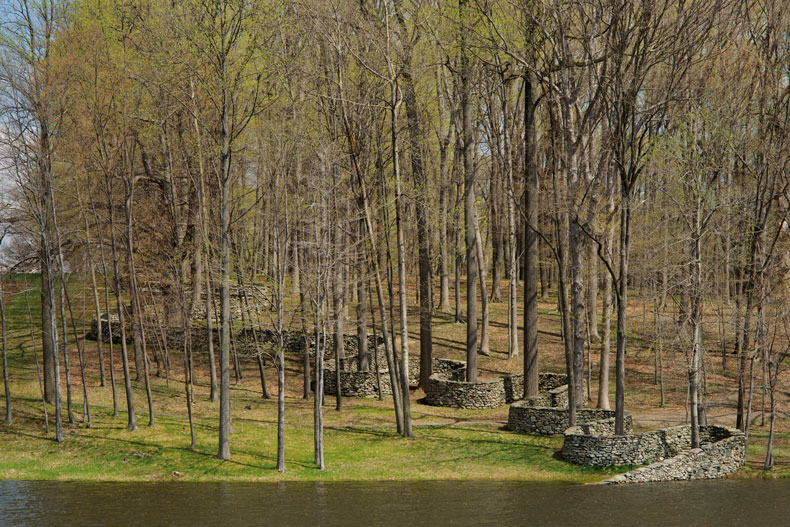
Once through the new entry pavilion, visitors continue down a central pathway, which is accessible by wheelchairs and mobility devices, ‘so everyone has this unified experience’, Lawrence says. ‘We can introduce people to Storm King in the same way every time.’ A short walk down the path leads to Alexander Calder’s totemic The Arch (1975) and the familiar main road, lined by sugar maples, heading up a hill to the museum building, a former manor house styled after a French chateau and originally built in 1935. That is where the Brazilian artist Sonia Gomes has her debut US museum show, including her first public outdoor work, a pendulous installation of colourful textiles, found objects and organic materials suspended from the branches of a large tree, like plush wind chimes.
Another exhibition timed for the reopening is the 11th edition of Storm King’s Outlooks programme, which gives emerging and mid-career artists the chance to present a temporary project outdoors. This year’s artist is the photographer and film-maker Dionne Lee, who has created her first ever outdoor sculptures in the South Fields, comprising stones sourced on site which she coated in cyanotype chemicals and left to expose in the sun. Lee then etched the surfaces of the stones with a power tool to create petroglyphic markings, some referencing symbols such as dowsing rods or compass points, or outlining the natural form of the rock. A deep shade of oceanic blue when they were first completed in late March, the works will slowly evolve over the course of the year, fading in the light. ‘She was thinking about fossils as a really early non-human type of photography,’ Lawrence says.
‘One thing we love about these projects,’ Lawrence adds, ‘is how much they encourage an artist to think about a turn in their practice, and move them into a place that they didn’t necessarily know they’d be going.’ ‘I think it’s unusual for a younger artist to basically be told, “Here’s a huge landscape, go to town. Let’s think about what you might want to do in this new medium.” When you don’t have the resources, [when] you don’t have a team behind you, it’s not something you’re naturally thinking to do.’
View of Storm King Wavefield (2007–08) by Maya Lin, which comprises seven rows of rolling waves dug out of the ground. © Maya Lin
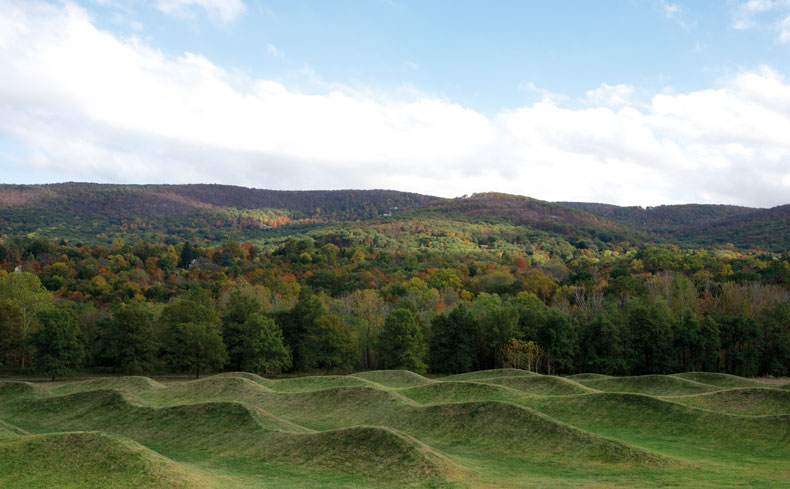
Helping artists to realise projects that are outside of their usual comfort zones is part of the curatorial ethos at Storm King, along with decades of practical knowledge about installing and displaying art in nature and all the complications that come with it, from frozen ground to seasonal flooding. ‘We’ll say, “You know, this is going to work better than that, here’s why.”’ Lawrence says. ‘Or sometimes there’ll be a site that someone chooses, and we tell them, “You should know that the entire month of April, that’s going to be a swamp.”’
In this way, perhaps one of the most important pieces of this expansion is something that most visitors will not see, located past the southern edges of the publicly accessible parts of the campus. The new David R. Collens building for conservation, fabrication and maintenance is named after Storm King’s former director and chief curator, who retired in 2021 after more than 40 years at the helm. This 670-square-metre industrial-scale building provides a space for the museum to restore and preserve its monumental works of art – during our visit, sculptures by Ellsworth Kelly and George Rickey were being conserved – as well as to help create new projects by artists working in residence or in collaboration with the fabrication team on site.
View of Stacked Heads (2020) by Rashid Johnson, which consists of two bronze heads decorated with plants. Photo: Jeffrey Jenkins; © Rashid Johnson

The building’s cavernous wood shop has double-height hangar doors along one side that make it easy to transport large-scale works into and out of the space. A key feature is a 15-metre-long, five-metre-wide spray booth lined with high-powered lights and connected to a room-sized HVAC system that will be used to paint works before they are displayed outdoors, avoiding the risks of bad weather or bits of grass blowing on to a still-wet surface. ‘It’s designed so that you can back a flatbed truck up into it,’ according to Lawrence. ‘We’re really excited about it because so much of the work that would have to be outsourced, we can now do ourselves.’
Louise Nevelson’s City on the High Mountain (1983), for example, one of the mainstays on Museum Hill, had to be shipped to Virginia for conservation in 2017, in a collaboration with the Getty Conservation Institute and the US Army Research Laboratory. (The project was a case study to see if the matt paint used on military helicopters would also be suitable for works of art.) Among the objects already produced on site at Storm King are the painted metal buttresses that will hold up Kevin Beasley’s installation.
More practically, the Collens building also houses Storm King’s small fleet of riding lawnmowers and other maintenance equipment, and a soil testing lab to ensure that the grounds are in the best condition for new growth. An upstairs space includes seminar rooms for visiting artists, students or scholars, and offices for the operations staff. ‘Before, we had no building, really, to serve all the functions needed – we had a small converted garage,’ Lawrence says. ‘So this has been a huge upgrade.’
View of Ó Abre Alas (2025) by Sonia Gomes. Photo: Jacob Vitale; courtesy the artist/Mendes Wood DM/Pace Gallery; © Sonia Gomes
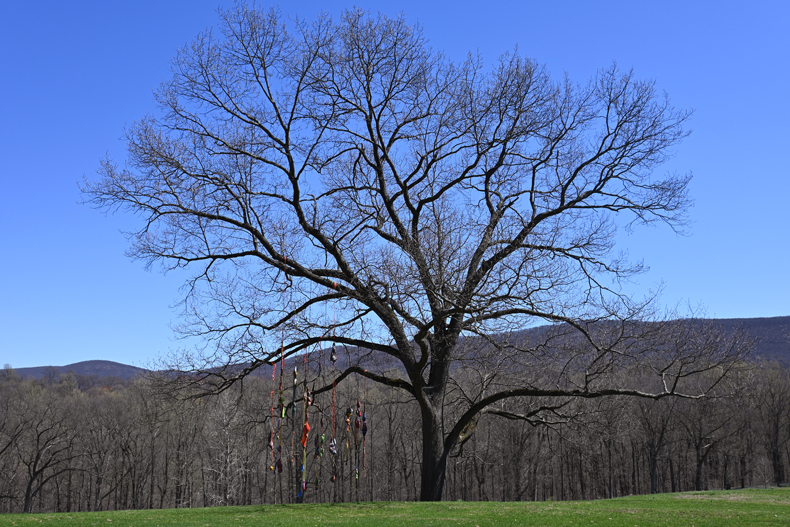
Storm King Art Center in Mountainville reopens on 7 May.
From the May 2025 issue of Apollo. Preview and subscribe here.
